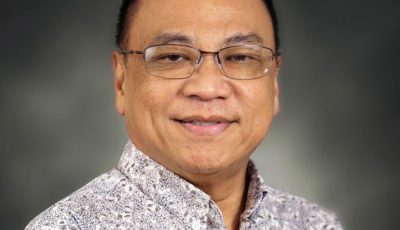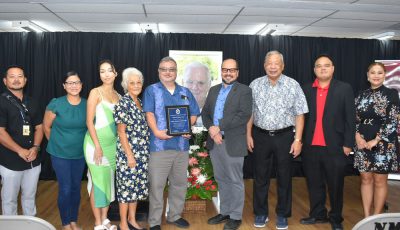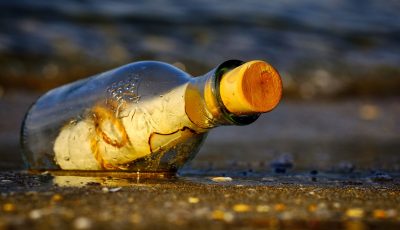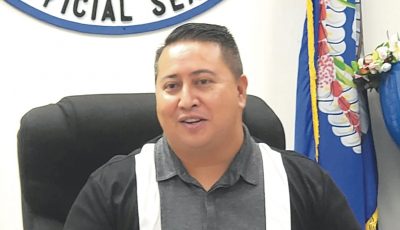Facility naming and art rendition on the sports complex on Saipan
Editor’s Note: The following is the text of a letter the author recently sent House Speaker Edmund S. Villagomez and Senate President Jude U. Hofschneider of the 22nd Northern Marianas Legislature in the Commonwealth of the Northern Mariana Islands.
On Friday, Dec. 3, both the House of Representatives and the Senate convened for a joint presentation to receive communication by the officials and leaders of the Pacific Mini Games, which the NMI will be hosting in the summer of 2022.
Having said that, it is our mission to ensure that proper information is provided and shared with the nearly 2,000 visitors—athletes, couches, support staff, families, and fans—who will be arriving in the Northern Mariana Islands beginning June 10, 2022, for the Pacific Mini Games.
Several years ago, former representative Ramon A. Tebuteb and governor Juan N. Babauta were successful in renaming the Gilbert C. Ada Gymnasium, the Francisco “Tun Ko” Palacios Baseball Field, and the Track-n-Field as the “Oleai Sports Complex” without any input from the families whose family namesake were dedicated to these respective facilities; or the Chamorros who are the natural owners of these lands, whose ancestors and their burial ground continue to host the sports complex today.
We are aware of, and the importance of, the historical accounts of the people of the Caroline Islands now referenced today as Micronesia—Satawal, Woleai, Lamotrek, Ulithi, Sonsorol, Tobi, Pulusuk, Polowat, etc.—that were brought to the NMI by colonizers of the Mariana Islands to prevent continued death from starvation, and some were used as workers. And some of the Carolinians also immigrated from their respective islands and atolls in the Carolines to survive the typhoon-ravaged islands and atolls 200-plus years ago. This is our islands’ history, but it is not the only history of our native people, the Chamorros, and our ancestral islands, the Marianas.
In fact, the people from Caroline Islands of Namunouito, Chuuk were brought to Guahan and Tinian in the 1700s specifically as agriculture laborer by Sir Anderson and company, a European and Chamorro entrepreneur. Some of the laborers returned to Chuuk, and some were later resettled at i Sengsong Achugao and i Sengsong Tanapag in Saipan. But these traditional villages and ancestral Chamorro Island of Tinian were never renamed “Namunouito village” or “Namunouito Island” to insult the indigenous people of Achugao and Tanapag villages and the native people of Maga’lahi Taga’s island on Tinian.
In fact, some of the descendants of the people from the Caroline Islands of Yap who were resettled by the U.S. military on Tinian immediately after World War II in 1947 had ancestral and cultural lineage to the main island of Yap. Yet these Chamorro-Yapese descendants did not rename their traditional village i Sengsong Makpo or the colonial reference San Jose village on Tinian to that of Yap or Yap’s villages of Gagil, Rumung, Gilman, Mapp, etc.
Additionally, a group of people from the island of Samoa were brought to the Northern Marianas during the German colonial occupation of the NMI and other Pacific Islands. These Samoans were later resettled in the traditional Chamorro villages of Achugao and Tanapag in the early 1900s. Yet, these traditional villages were never renamed Samoa, Pago Pago or Apia village to insult the native islanders.
Again, our leaders, elected and appointed, must understand that all these turn-of-events in the Northern Marianas were incidents of colonialism and at times tragic events for the Taotao Tano, the native Chamorros.
But to add insult and assault on the native people of the Northern Marianas is that huge artwork on the wall of the Gilbert Ada Gymnasium building depicting the Carolinian floral wreath that overshadowed the Achu Latte (Latte Stone), a sacred symbol to all Chamorros around the world.
In fact, the floral wreath and the artwork word “Marianas” desecrated the Latte structure beyond existence and recognition. This artwork was used since last year as the beginning of the marketing art of the “Oleai Sports Complex” in preparation for the Pacific Mini Games. This artwork is out there in the worldwide web for everyone to see and witness how the CNMI government, the U.S. federal agency, and the leaders in the CNMI are treating the indigenous people by allowing this desecrated Achu Latte as a symbol welcoming the thousands of athletes and visitors to the Marianas, the ancestral home of the native Chamorros.
Additionally, this artwork on the gym faces one of the island’s busiest highways. It is fully funded in part by the CNMI government’s Arts Council under the Department of Community and Cultural Affairs, and the U.S. federal government grants under the National Endowment for the Arts—that have allowed for this cultural misappropriation against the natives to exist in this 21st century.
In fact, this same artwork (without the Latte stone) was so prominent that it was used by the NMI Democrat Party as the party’s official art logo on all their billboards and signboards throughout the NMI for the 2020 mid-term election, despite our official protest against this insult and assault on our sacred symbol—Achu Latte. They refused to heed our protest.
To this end, we continue to advocate to right the wrongs of the past about, and of our people, and our islands. Therefore, we urgently ask the elected and appointed officials of our government to make it right for our people and our islands’ history. It is the elected and appointed officials of our government that have done the wrongs on these issues in the last 45 years. Take note that the nearly 2,000 visitors who will be in the Northern Mariana Islands are all from indigenous communities.
The “Oleai Sports Complex” is not only about the people of Woleai Atoll, Caroline Islands because there are other Carolinians from the other Caroline Islands and atolls who were here at the same time the Woleaian arrived in the Marianas 200 years ago. It is about the Chamorros whose thousand-year-old ancestors’ remains that were disinterred and displaced from their natural burial ground to make way for the construction of the sports complex that is still there at their traditional village of i Sengsong Katan Uda and i Songsong Susupe; and now colonially referenced as San Jose and Susupe villages.
It is ironic that this year, 2021, marked the 500th year since the landing of the first contact between the Chamorros and the West on March 6, 1521. In fact, to commemorate the significance on the landing of the Portuguese explorer Ferdinand Magellan on our shores, the Spanish Navy training ship Juan Sebastian De Elcano arrived at Guahan’s Apra Harbor on Feb. 26, 2021, and departed March 2, just days before the abrupt departure of Magellan from the Marianas 500 years ago.
The ship was received by Guahan’s Maga’haga Lou Leon Guerrero, Lt. Gov. Joshua Tenorio, and Commander Joint Region Marianas Rear Adm. John Menoni. The ship’s namesake, Juan Sebastian De Elcano, was the Spanish explorer who completed the journey back to Spain after Magellan was killed in the Philippines. The Elcano’s visit commemorates the 500th anniversary of the Magellan-Elcano circumnavigation and the 500th year since the beginning of colonialism of the indigenous people, i Taotao Tano, the Chamorros. We must know and understand our history. We will not yield any longer.
On behalf of the Matua Council, we are asking that the sports complex be properly and promptly renamed Mariana Islands Sports Complex to reflect the islands, its people, and its history. More importantly, it represents all the islands in the NMI, its people, and all athletes from the Northern Marianas: aipan, Tinian, Luta and Gani.
Lastly, an artist must be commissioned to make the necessary correction to the Gilbert Ada gym’s wall to ensure the Achu Latte, the sacred symbol of the Taotao Tano, is prominent to show and give respect to the ancient Chamorros whose remains continue to host the sports complex facilities. This is making it right and justice for the native people.
In closing, we trust that you will take this request with utmost urgency because it is less than 200 days before the arrival of the first batch of visitors to Saipan for the Pacific Mini Games. Let this be a successful story for the NMI—our athletes, our visiting athletes and their delegation, the leadership of the Pacific Mini Games, volunteers, supporters, the CNMI government, and everyone in the NMI who make and call these islands home.
Liana M.S. Hofschneider is president and CEO of Matua Council for Native Chamorro Advancement.



























